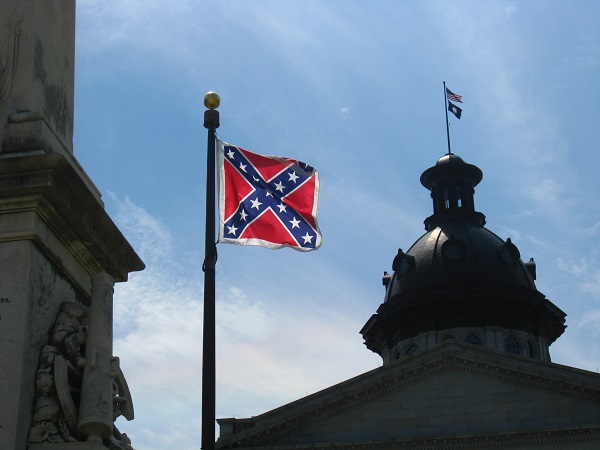While the nation mourns the loss of nine murdered African-American churchgoers in Charleston, the Confederate flag flies high as ever beside South Carolina’s capitol.
Some people have criticized this display as insensitive, disgusting and offensive; others are disgusted by the criticism.
This is not the first time the Confederate flag has provoked argument among Southerners (and their well-meaning friends). However, the recent murders have injected fresh energy into the push to bring the flag down (or keep it up, depending on one’s view).
Let us think healing thoughts, and let us also be honest: the symbols we choose for ourselves matter.
Symbols matter, of course, in terms of history: these are the people and the stories we choose to remember.
When we use our symbol, we are telling the world to pay attention: here is something important.
This thing happened; these people lived; this story changed us, somehow. It shaped our world.
Look at this symbol. Remember.
But symbols are more than recited memory.
Symbols, at their best, are the light-bringers in times of crisis.
They should unify, speaking past fear, past selfishness, to the hearts of all in the community.
They should resonate with hope.
They should remind us what our people have already overcome.
They should help us to define our cause, and tell us at once: What is the thing we will all fight for?
When conflicts arise, which value will always win?
What great goal shall we strive toward?
Symbols are the means by which we write our introduction to the far-flung future.
The grandchildren of our grandchildren’s grandchildren will look to our symbols to determine what mattered most to us.
We can expect them to be wiser than us in any number of ways.
We can expect them to judge us not through the veiled vision of our time, but with the crystalline sharpness of their own.
They will not suffer the attachments which cloud our decisions.
They will not be fooled.
We possess both the liberty and the responsibility to scrutinize the symbols we have inherited.
We are not bound by the pressures our ancestors endured, nor by their limitations in vision.
We are free.
And yet we are but brief stewards of larger stories that have been developing through the course of centuries.
Our duty is not to pass symbols blindly to the next generation, but to examine each item closely.
Of each symbol we should ask: What are its values, exactly?
Is this still whom we are?
Is this whom we wish to be?
We cannot pretend that the Confederate flag does not evoke wildly intense, wildly diverse emotions.
One either loves it or hates it.
This flag is simultaneously an emblem of coziest home and systemic oppression, endearing spunk and unforgivable treason, honorable deeds and acts of terror, human slavery and individual rights (and the exact rights sought by the Confederacy are themselves points of vitriolic argument).
The flag is so divisive that one cannot even call it a Confederate flag without causing offense.
Its supporters are ever quick to point out that it never belonged to any attempted nation-state, but was always a battle flag, carried by a subset of the Confederate armed forces during the American Civil War.
Very well.
If we call it the flag specifically designed to accompany men who were trying to kill other men, can we say this is a symbol we still want?
Is this unifying?
Is this community-building?
Is this the story we want our distant descendants to associate with us?
What does this flag mean?
This flag is never discussed without a war of words and occasional facts, spun and flung with all the vengeance of a 19th-century artillery barrage (and half the accuracy).
This flag is a reminder that 150 years have passed, and we cannot even agree why the men who marched beneath it were trying to kill other men.
We cannot agree on the nature of slavery, slave-owning, slave-trading, slave culture, slaves in uniform, the likely fate of slavery without federal intervention, or pretty much anything involving the S word.
We cannot agree on the boundary between heritage and hate, we are unsure of the line between hero and villain, and we are utterly lost as to what constitutes a modern incident of racism.
If this flag means anything, it would seem to be “division,” or perhaps, “brokenness.”
Let us be honest: there are symbols which belong to one era only, and cannot serve us any longer if we wish to grow.
Let us not just be shufflers along the path of time.
Let us be conscious points in the story of human development.
Let us consider our past, our present, and the path we would most like for the future.
Let us recall our highest values.
Let us think healing thoughts.
Let us choose our symbols wisely.
Relephant Read:
Beyond Charleston: Racism is Learned, so Let’s Stop Teaching It.
Author: Katie-Anne Laulumets
Editor: Emily Bartran
Photo: eyeliam via Flickr







Read 2 comments and reply